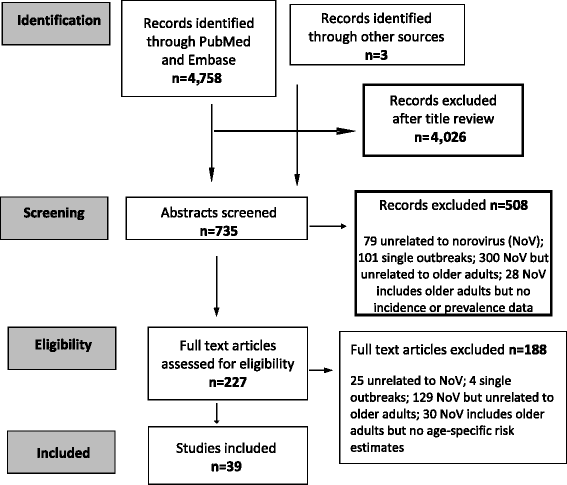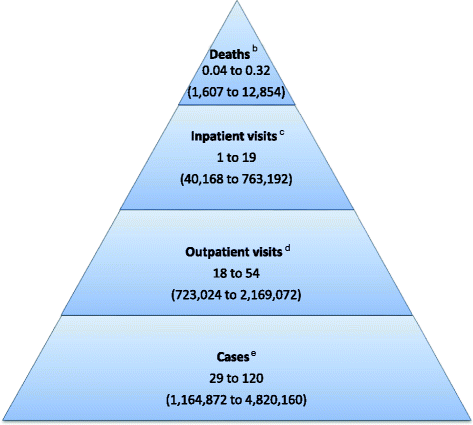A decade of norovirus disease risk among older adults in upper-middle and high income countries: a systematic review
- PMID: 26467099
- PMCID: PMC4606836
- DOI: 10.1186/s12879-015-1168-5
A decade of norovirus disease risk among older adults in upper-middle and high income countries: a systematic review
Abstract
Background: Noroviruses (NoVs) are the most common cause of acute gastroenteritis (AGE) causing both sporadic and outbreak-associated illness. Norovirus (NoV) infections occur across all ages but certain sub-groups are considered at increased risk due to heightened transmission and/or symptom severity. Older adults are potentially at high risk of NoV-associated illness due to frequent outbreaks in long-term care facilities (LTCFs) and severe health outcomes following infection. Elucidation of NoV risk among older adults will support prevention, treatment and control efforts.
Methods: We conducted a systematic literature review to summarize the published risk estimates of NoV-associated illness, hospitalization and death among individuals aged 65 years and older. A structured search using defined NoV and gastroenteritis (GE) terms was performed in the PubMed and EMBASE databases of human studies published between January 1, 2003 and May 16, 2013.
Results: We identified 39 studies from high income (HI) and upper-middle income (UMI) countries. Thirty-six percent of publications provided risk estimates based on laboratory-confirmed or epidemiologically-linked population-based surveillance data using molecular diagnostic methods. Over the study period, estimated annual NoV rates and extrapolated number of cases among older adults in HI and UMI countries were: 29-120/10,000 or 1.2-4.8 million NoV-associated illnesses; 18-54/10,000 or 723,000-2.2 million NoV-associated outpatient visits; 1-19/10,000 or 40,00-763,000 NoV-associated inpatient visits; 0.04-0.32/10,000 or 2000-13,000 NoV-associated deaths. NoV was responsible for approximately 10-20 % of GE hospitalizations and 10-15 % of all-cause GE deaths among older adults. Older adults experienced a heightened risk of nosocomial infections. Those in LTCFs experience frequent NoV outbreaks and the range in attack rates was 3-45 %, case hospitalization rates 0.5-6 % and case fatality rates 0.3-1.6 %.
Conclusions: Older adults are at increased risk of severe NoV-associated health outcomes. NoV-associated hospitalization rates were higher, more severe, resulted in longer stays and incurred greater costs than for younger patients. NoV-associated mortality rates were approximately 200 % higher among individuals 65 years and older compared to <5 years. The burden of NoV among older adults is expected to rise along with societal aging and increased need for institutionalized care. NoV prevention in older adults, including potential vaccination, may significantly impact risk of severe illness.
Figures


References
-
- Wikswo ME, Hall AJ. Outbreaks of Acute Gastroenteritis Transmitted by Person-to-Person Contact - United States, 2009–2010. Morbidity and mortality weekly report Surveillance summaries (Washington, DC : 2002) 2012;61(9):1–12. - PubMed
Publication types
MeSH terms
LinkOut - more resources
Full Text Sources
Other Literature Sources
Medical

